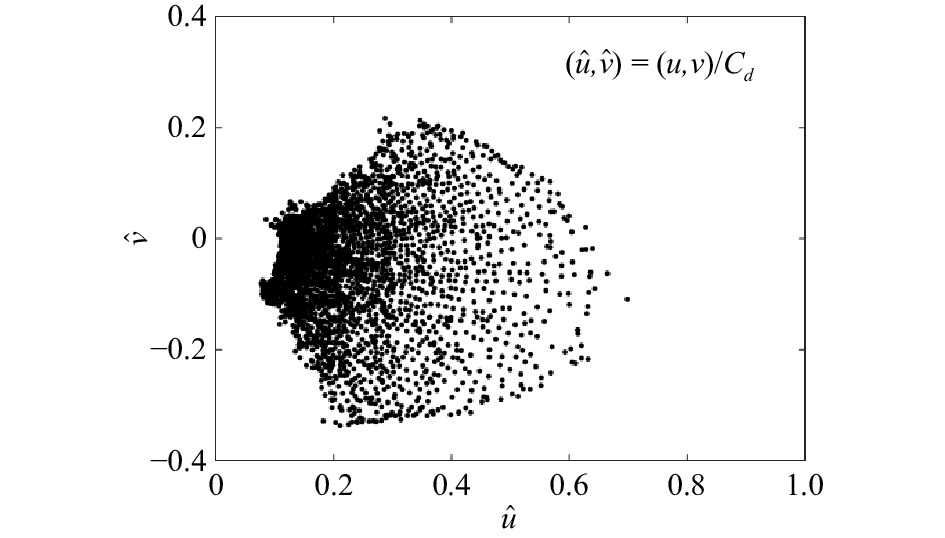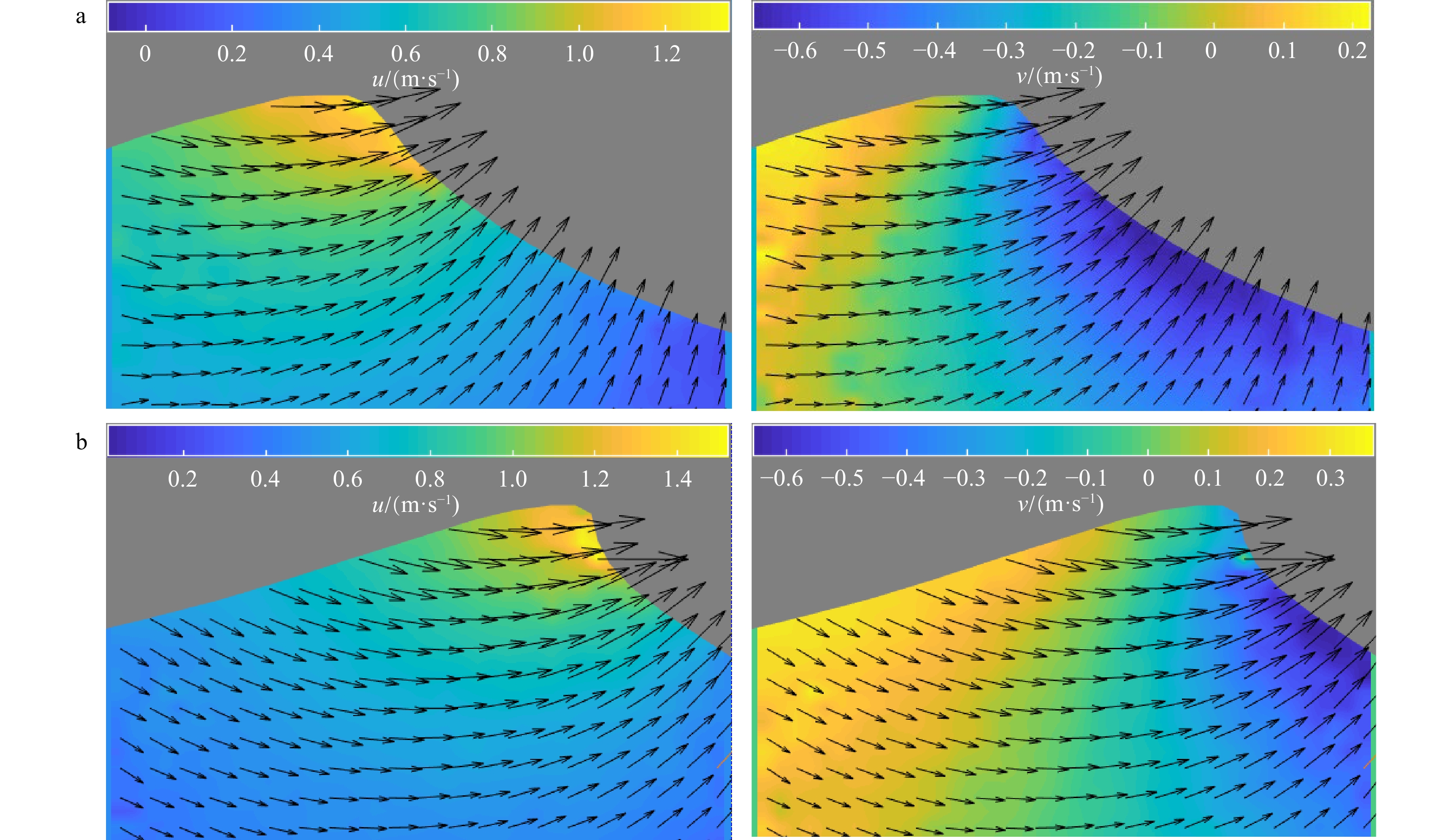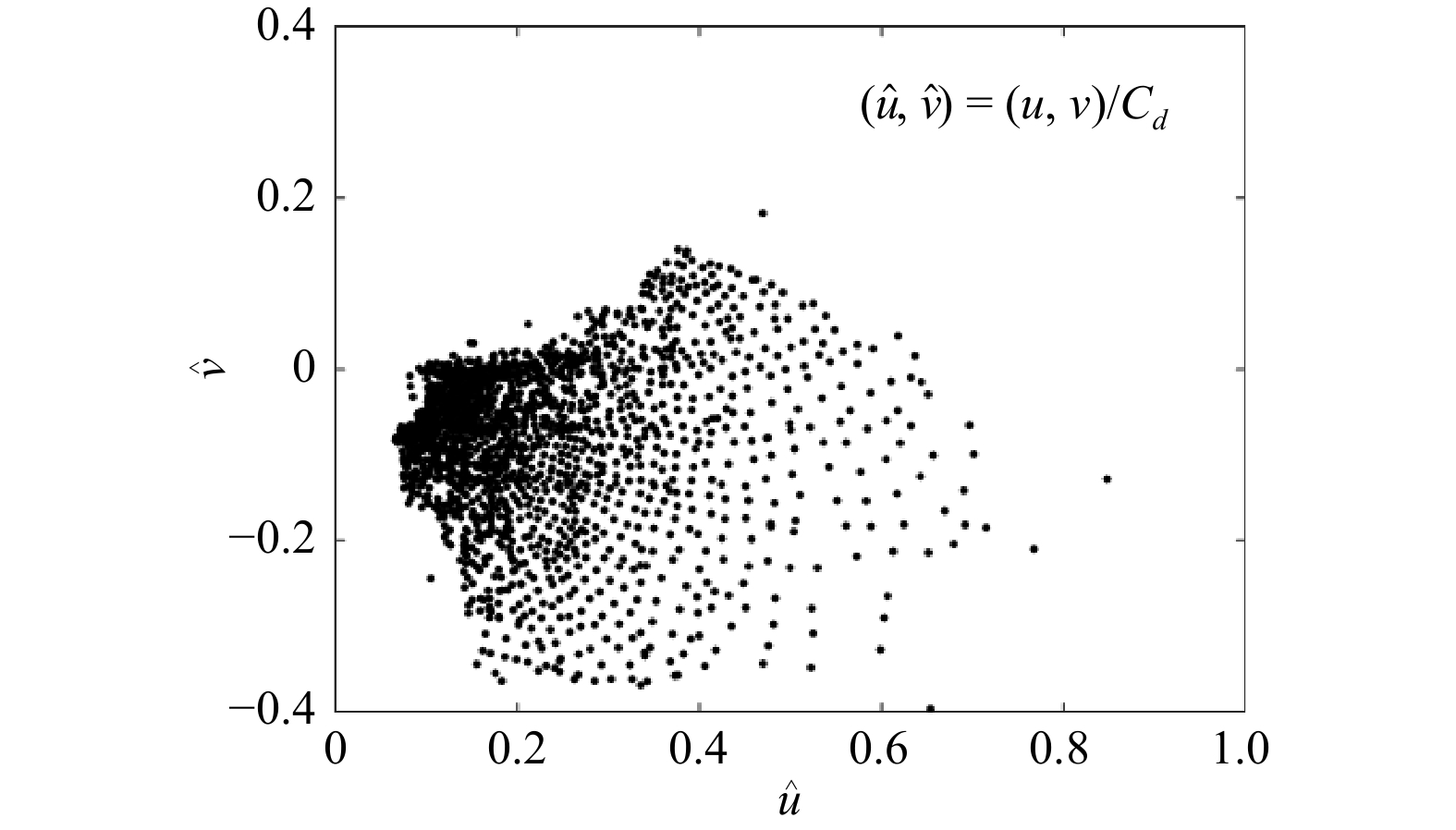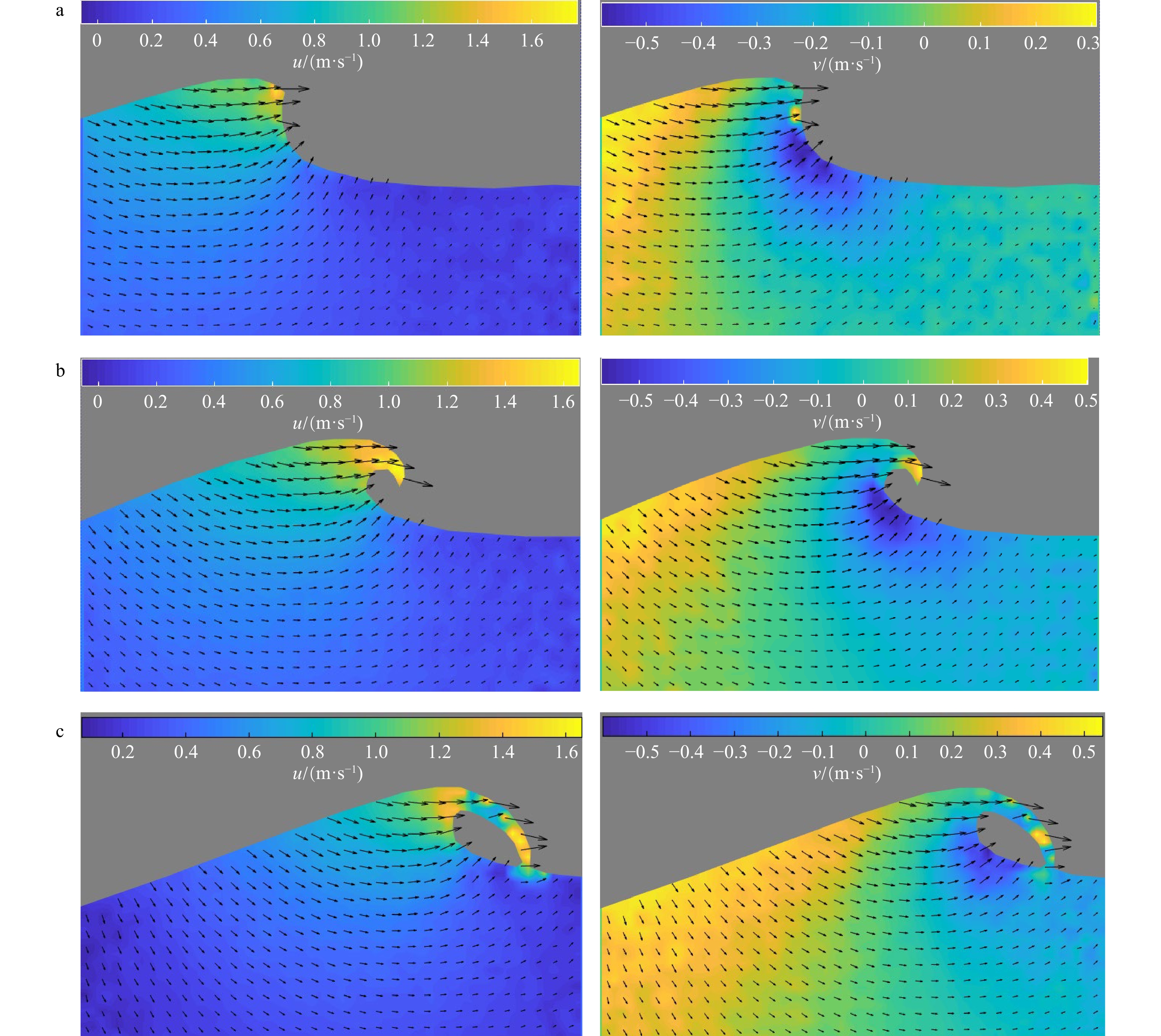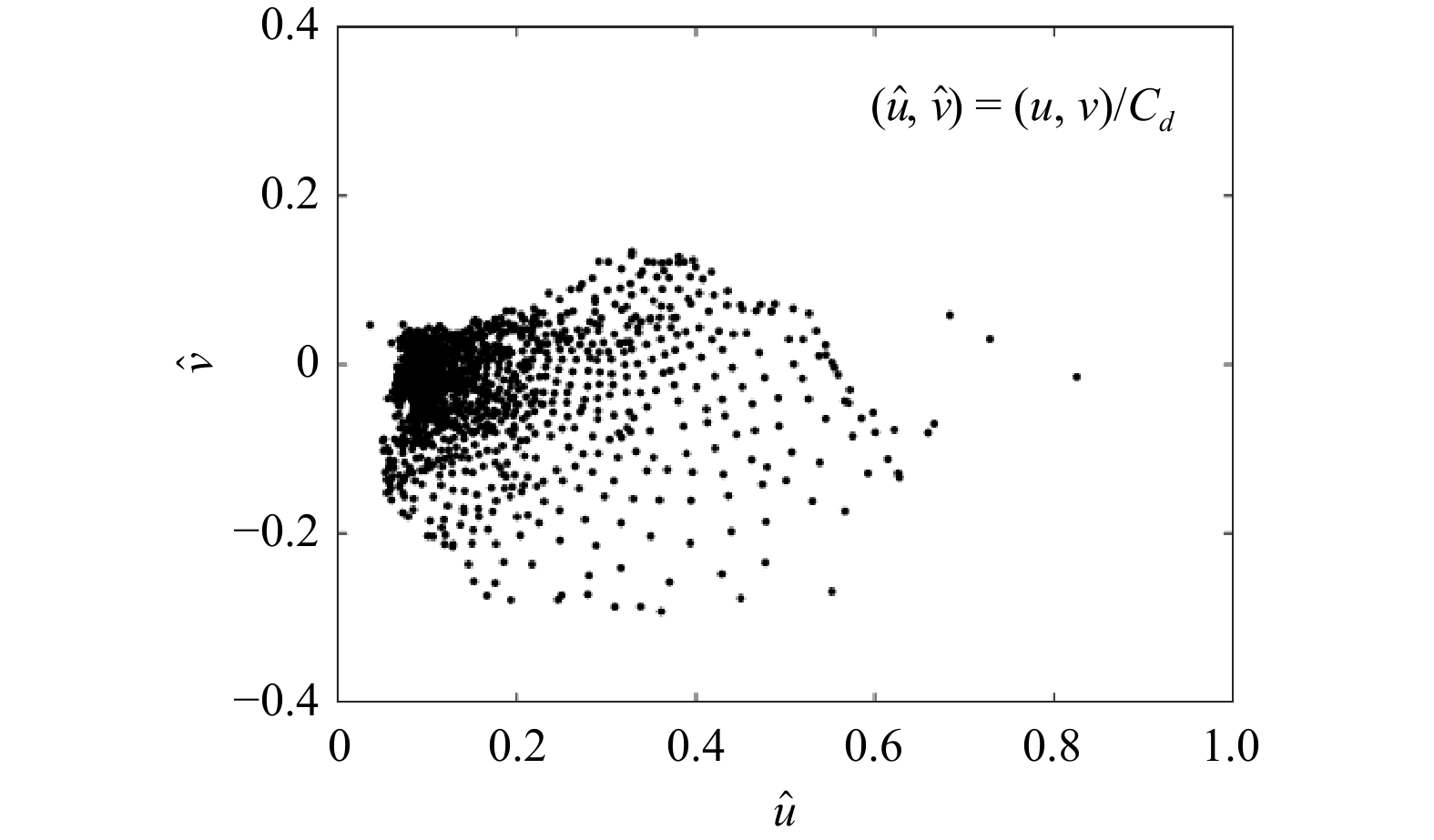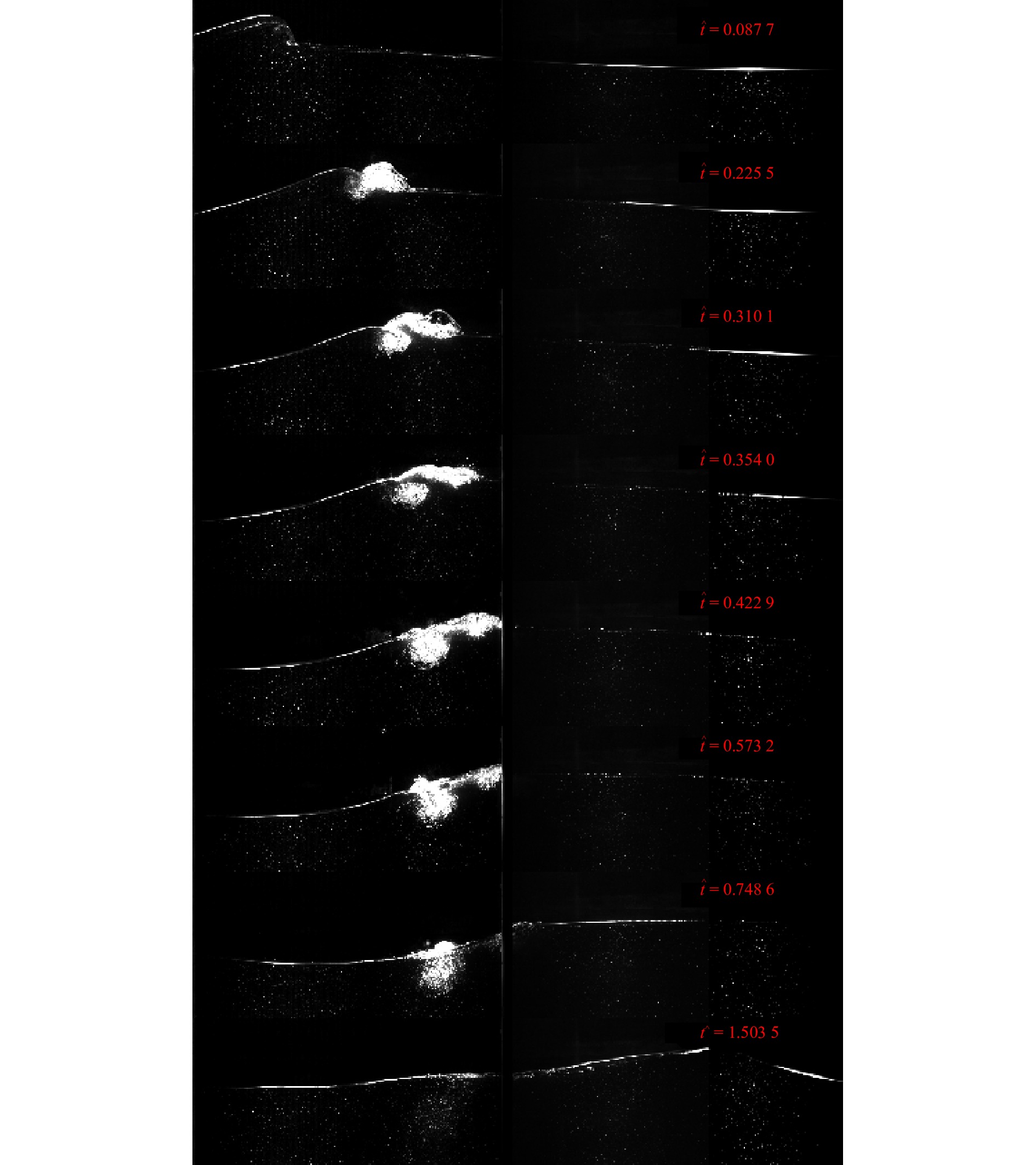Study on development characteristics of gas-liquid mixture zones and kinematics of breaking wave with different breaking type
-
摘要: 了解波浪破碎速度场的分布特性对于波浪破碎物理机制的研究极为重要,同时,对比研究不同类型破碎产生的气液混合区的演化特征有利于波浪白冠覆盖率模型的完善。在实验室水槽,生成了深水临界波、单次崩破波和单次卷破波,采用图像测速技术获取了波浪破碎图像、波面下水体和气液混合区速度场。结果表明,崩破波的水平向速度u和垂直向速度v在波峰前和波峰后的分布极为不对称,其水平向最大速度umax并不位于峰顶,而是在主导波峰前0.7
$\eta_{\max} $ 处;卷破波的umax出现在波峰峰顶前端极小的区域内,且该区域与周围区域的速度梯度极大。崩破波和卷破波生成的气液混合区发展特征也存在差异:崩破波的umax值大、影响区域长、混合区厚度较小、各区域影响时间短;而卷破波的各项特征参数与崩破波形成对比。Abstract: To understand the internal physical mechanism of wave breaking, it is important to study the distribution characteristics of the particle velocity field under breaking wave. In addition, a comparative study of the evolution characteristics of the gas-liquid mixing zone caused by different types of breaking is beneficial to the improvement of the whitecap coverage model. In the laboratory wave flume, a critical wave, a single spilling wave, and a single plunging wave are generated in deep water based on the linear phase focusing theory. The velocity fields below the wave surface and the velocity fields in the gas-liquid mixing zone are measured using particle image velocimetry (PIV) and bubble image velocimetry (BIV), respectively. The distribution characteristics of the velocity field at the extreme state of different breaking types are compared and discussed. The results show that the horizontal velocity u and vertical velocity v of the spilling wave are extremely asymmetrical in the front part and back part of the wave crest. In addition, the maximum horizontal velocity umax is not at the top of the wave peak, but at the pre-peak position about 0.7$\eta_{\max} $ front part and back part of the wave crest. In addition, the maximum horizontal velocity of the peak. For plunging wave, the maximum horizontal velocity umax appears at the top and very front of the wave peak with a very small region, and the velocity gradient between this area and the surrounding area is very large. The development characteristics of the gas-liquid mixing zone produced by different wave breaking also have differences. For spilling wave, the gas-liquid mixing zone generated by breaking has high horizontal movement speed, long influencing area, short influence time at each location, and small thickness. For plunging wave, the gas-liquid mixing zone has relatively slow horizontal movement speed and larger vertical input, shorter affected area, longer affected time at each location, and greater thickness.small thickness. However, for plunging wave, these characteristic parameters are in contrast with those of the spilling wave. -
图 11 崩破导致混合区影响深度随时间的变化(左列)和混合区最大水平向速度与水体最大水平向速度的比较(右列)
混合区最大水平向速度由BIV测量获得,水体最大水平向速度由PIV测量获得
Fig. 11 Spilling wave, the thickness of mixed zone varies with time (left column) and the comparison of the maximum horizontal velocity
$ \hat{u}_{\max}$ in mixed zone and the maximum horizontal velocity$ \hat{u}_{\max}$ in water body (right column)Maximum horizontal velocity $ \hat{u}_{\max}$ of the mixed zone is measured by BIV, maximum horizontal velocity $ \hat{u}_{\max}$ of the water body is measured by PIV
图 12 卷破导致混合区影响深度随时间的变化(左列)和混合区最大水平向速度与水体最大水平向速度的比较(右列)
混合区最大水平向速度由BIV测量获得,水体最大水平向速度由PIV测量获得
Fig. 12 Plunging wave, the thickness of mixed zone varies with time (left column) and the comparison of the maximum horizontal velocity
$ u_{ \max } $ in mixed zone and the maximum horizontal velocity$ u_{ \max } $ in water body (right column)Maximum horizontal velocity $ u_{ \max } $ of the mixed zone is measured by BIV, maximum horizontal velocity $ u_{ \max } $ of the water body is measured by PIV
表 1 试验工况参数
Tab. 1 Experimental conditions
工况 fp Sinput $ \Delta f $ γ 破碎类型 1 0.8 0.33 0.56 6.0 临界波 2 0.75 0.38 0.64 3.3 崩破波 3 0.75 0.35 1.46 3.3 卷破波 表 2 不同破碎类型特征参数的对比
Tab. 2 Comparison of characteristic parameters of different breaking types
破碎
类型极限状态运动
特征参数气液混合区特征参数 速度场分布 $ u_{ \max } $ 总长度Lm 总时长Tm Dmax tmax $ u_{ \max } ^m$ 临界波 对称 0.66Cd 崩破波 极不对称 0.84Cd 1.15Ld 1.86T 0.75$ \eta_{\max}$ 0.6T 1.5Cd 卷破波 不对称 0.83Cd 0.5Ld 2.0T 1.55$ \eta_{\max}$ 1.0T 1.0Cd -
[1] Wanninkhof R, Asher W E, Ho D T, et al. Advances in quantifying air-sea gas exchange and environmental forcing[J]. Annual Review of Marine Science, 2009, 1: 213−244. doi: 10.1146/annurev.marine.010908.163742 [2] Grue J, Clamond D, Huseby M, et al. Kinematics of extreme waves in deep water[J]. Applied Ocean Research, 2003, 25(6): 355−366. doi: 10.1016/j.apor.2004.03.001 [3] Grue J, Kolaas J, Jensen A. Velocity fields in breaking-limited waves on finite depth[J]. European Journal of Mechanics-B/Fluids, 2014, 47: 97−107. doi: 10.1016/j.euromechflu.2014.03.014 [4] Grue J, Jensen A. Experimental velocities and accelerations in very steep wave events in deep water[J]. European Journal of Mechanics-B/Fluids, 2006, 25(5): 554−564. doi: 10.1016/j.euromechflu.2006.03.006 [5] Grue J, Jensen A. Orbital velocity and breaking in steep random gravity waves[J]. Journal of Geophysical Research: Oceans, 2012, 117(C7): C07013. [6] Lim H J, Chang Kuang’an, Huang Zhicheng, et al. Experimental study on plunging breaking waves in deep water[J]. Journal of Geophysical Research: Oceans, 2015, 120(3): 2007−2049. doi: 10.1002/2014JC010269 [7] Na B, Chang Kuang’an, Huang Zhicheng, et al. Large-scale laboratory observation of flow properties in plunging breaking waves[J]. Coastal Engineering, 2018, 138: 66−79. doi: 10.1016/j.coastaleng.2018.04.002 [8] 台兵, 马玉祥, 董国海, 等. 孤立卷破波传播演化特征分析[J]. 哈尔滨工程大学学报, 2021, 42(6): 778−784.Tai Bing, Ma Yuxiang, Dong Guohai, et al. Characteristics of propagation and evolution of plunging solitary waves[J]. Journal of Harbin Engineering University, 2021, 42(6): 778−784. [9] 龙晓警. 粒子图像测速(PIV)技术在水槽波浪中的研究[D]. 天津: 天津大学, 2009.Long Xiaojing. Particle image velocimetry investigation on waves in flume[D]. Tianjin: Tianjin University, 2009. [10] Gao Xiangyu, Dou Xiping, Gao Zhengrong, et al. Research of flow characteristics on spilling waves[J]. Procedia Engineering, 2015, 116: 64−70. doi: 10.1016/j.proeng.2015.08.265 [11] 易婧. 卷破波作用下卷入气泡特性研究[D]. 长沙: 长沙理工大学, 2017.Yi Jing. Analysis on the characteristic of the bubble entrained by the plunging wave[D]. Changsha: Changsha University of Science & Technology, 2017. [12] 毕小奇. 基于PIV及BIV耦合的破碎波浪特性研究[D]. 大连: 大连理工大学, 2020.Bi Xiaoqi. The study on the evolution characteristics of breaking waves based on PIV and BIV coupling[D]. Dalian: Dalian University of Technology, 2020. [13] 梁书秀, 张怡辉, 孙昭晨. 深水波浪破碎时波浪演化特征实验研究[J]. 海洋工程, 2016, 34(1): 71−79,123.Liang Shuxiu, Zhang Yihui, Sun Zhaochen. Experimental study on the evolution characteristics of deep-water breaking waves[J]. The Ocean Engineering, 2016, 34(1): 71−79,123. [14] Barthelemy X, Banner M L, Peirson W L, et al. On a unified breaking onset threshold for gravity waves in deep and intermediate depth water[J]. Journal of Fluid Mechanics, 2018, 841: 463−488. doi: 10.1017/jfm.2018.93 [15] Rapp R J, Melville W K. Laboratory measurements of deep-water breaking waves[J]. Philosophical Transactions of the Royal Society of London Series A—Mathematical Physical and Engineering Sciences, 1990, 331(1622): 735−800. [16] 华锋. 破碎波统计及应用研究[D]. 青岛: 中国科学院海洋研究所, 2005.Hua Feng. Study of breaking wave statistics and its application[D]. Qingdao: The Institute of Oceanology, Chinese Academy of Sciences, 2005. [17] Xu Yuanyuan, Liang Shuxiu, Sun Zhaochen, et al. An experimental comparison of the velocities and energies of focused spilling waves in deep water[J]. Ocean Dynamics, 2020, 70(7): 863−877. doi: 10.1007/s10236-020-01369-1 -







 下载:
下载:


